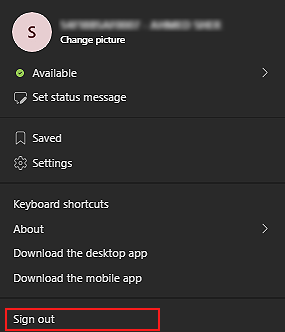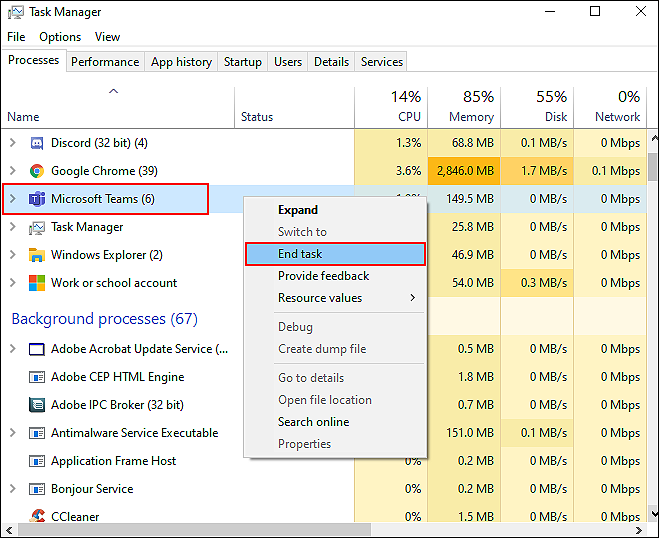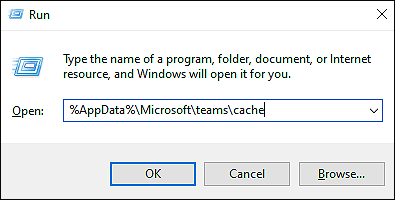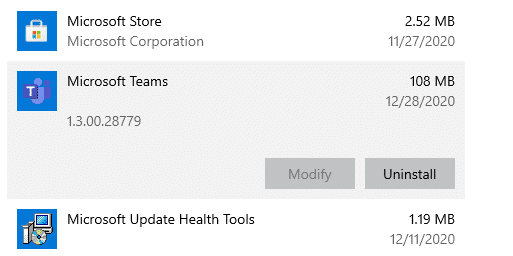Has Microsoft Teams stopped working on Windows 10?
Microsoft Teams is a collaboration app that helps you stay organized and in touch with your team members. It’s far more than a simple group video calling application as being integrated with Microsoft Office; Teams allows users to share Word documents, Powerpoint presentations, and Excel sheets with their coworkers on the app.
However, just like any other Microsoft application, Microsoft Teams is prone to errors.
Recently, several users reported that their Microsoft Teams app has suddenly stopped working on their PC, leaving them clueless about what to do next.
If you are facing a similar situation, you’re in the right place. This guide will walk you through the process of getting Microsoft Teams back up and running in no time.
Let’s get started.
1. Sign Out of Microsoft Teams.
If Microsoft Teams has stopped working on Windows 10 suddenly, the first thing you should try doing is signing out of your Teams account and then signing back in.
There are times when a temporary bug in the application prevents it from working properly and causes it to crash. The easiest way to eliminate such errors is by signing out of your account, ending the app’s task on your PC, and then signing back in.
Here is what you need to do:
- Open the Microsoft Teams app and click on your user icon at the top of the app.
- Locate Sign out from the list of options available and click on it.

- Once done, type Task Manager in the search bar and click Open.
- Locate Microsoft Teams in the list of apps available on your screen and right-click on it.
- Select End task to close Microsoft Teams and its related process.

- Finally, restart your PC, and upon rebooting, sign in to your Microsoft Teams account.
Hopefully, doing so will resolve the issue on your PC.
2. Remove MS Teams Cache.
When you open an app for the first time, the system stores temporary relevant files on the device. These data files are known as cache files, and they help the system retrieve data faster every time you revisit the application.
While these files have several benefits, they can sometimes get piled up and cause errors within the application. However, since these files are temporary, you can fix the errors simply by removing the cached files.
If the Microsoft Teams application has crashed on Windows 10, then try removing its cached files as doing so has helped several users fix the issue.
Here is all that you need to do:
- Type Task Manager in the search bar and click Open.
- Locate Microsoft Teams in the list of apps available on your screen and right-click on it.
- Select End task to close Microsoft Teams and its related process.
- Now open the Run dialogue box by pressing Windows + R keys simultaneously.
- Type the location mentioned below in the text field and hit Enter.
%AppData%\Microsoft\teams\cache

- Delete all the contents of the Cache folder.
- Once done, repeat the fourth step and, this time, delete the contents of all the folders mentioned below one by one.
%AppData%\Microsoft\teams\blob_storage
%AppData%\Microsoft\teams\databases
%AppData%\Microsoft\teams\application cache\cache
%AppData%\Microsoft\teams\gpucache
%AppData%\Microsoft\teams\Indexeddb
%AppData%\Microsoft\teams\Local Storage
%AppData%\Microsoft\teams\tmp
%LocalAppData%\Google\Chrome\User Data\Default\Cache
%LocalAppData%\Google\Chrome\User Data\Default\Cookies
%LocalAppData%\Google\Chrome\User Data\Default\Web Data
- Finally, try rerunning Microsoft Teams and check if doing so resolved the issue.
If corrupt cached files were causing the issue, deleting the folders mentioned above will fix it.
3. Try Using CleanMyPC.
As mentioned above, corruption errors within the system can prevent the apps from functioning correctly.
If removing the cached files did not do the trick for you, then there is a chance that a virus or corruption error within the operating system is causing the issue. In this case, we recommend deep cleaning your PC using an efficient PC cleaner. For the issue at hand, we recommend using CleanMyPC.

This tool will identify the corrupt files within your system and attempt to eliminate them automatically. Not just this, but it can also help you boost your PC’s overall performance and increase its speed.
All that you need to do is install CleanMyPC and run a scan. The rest will be taken care of!
4. Reinstall Microsoft Teams.
If none of the methods mentioned above works for you, this implies that the error under consideration cannot be resolved using the conventional troubleshooting methods. A simple solution to this issue is to uninstall the Microsoft Teams app from your PC and reinstall it.
Here is how you can do it:
- Go to Settings and select Apps.
- Now go to the Apps and Features window and scroll down to locate Microsoft Teams and Teams Machine-Wide Installer.

- Click on the Uninstall button to remove both the programs.
- Once done, restart your PC and install the Microsoft Teams desktop app again.
This should resolve the issue at hand once and for all.
This brings us to the end of our guide on fixing the Microsoft Teams issue on Windows 10. We tried walking you through all the steps in detail and hope that one of the methods helped you fix the issue once and for all. If you have any questions regarding the troubleshooting steps, please let us know in the comment section below!
If this guide helped you, please share it. 🙂





